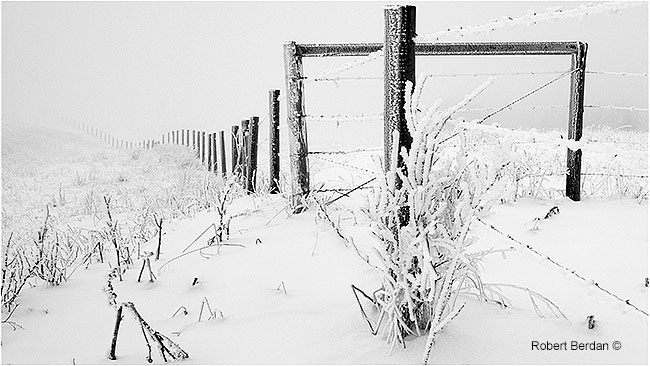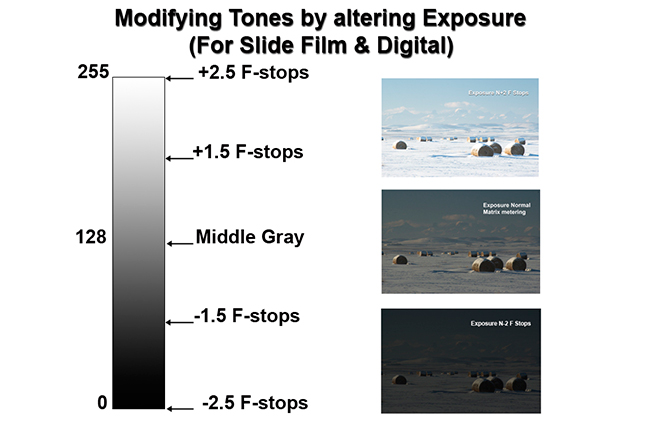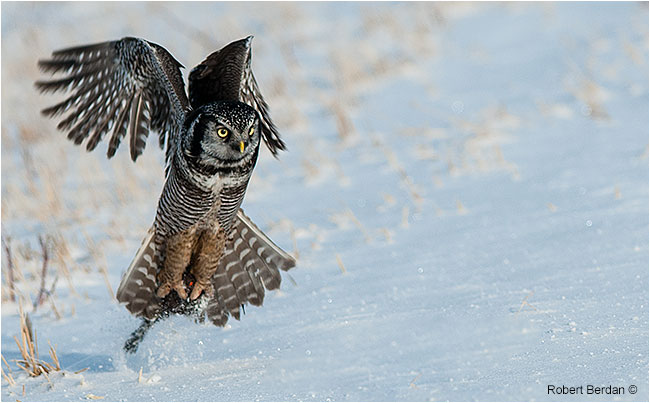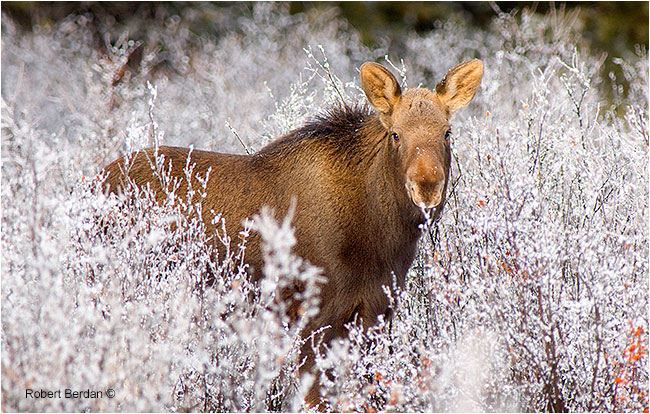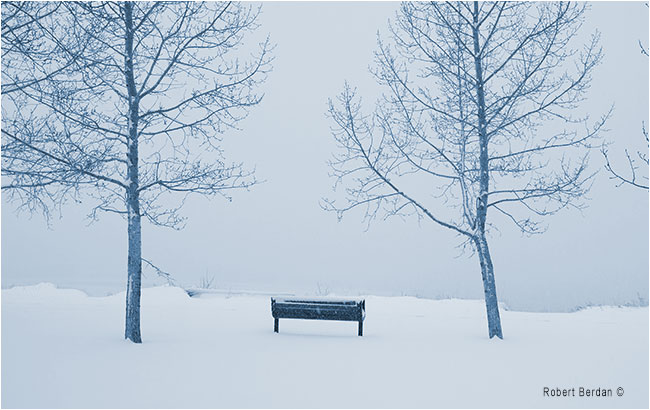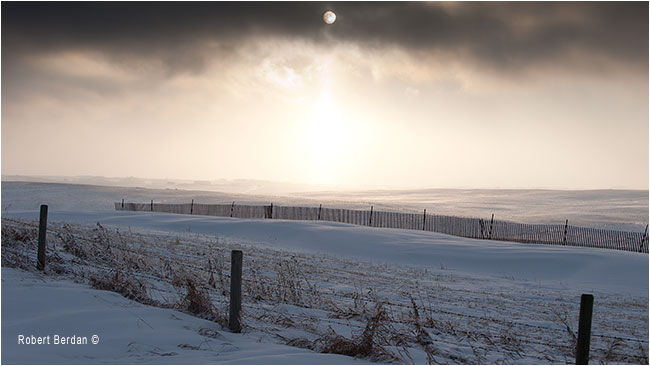
How a Camera Changed My Life &
Photographing in Winter
By Dr. Robert Berdan
December 22, 2012
Elbow Falls in winter - 3D Spherical movie photographed with 8 mm Fisheye lens and then stitched together. I will be featuring more of this type of photography in the near future. To view the movie full screen click here.
As we approach the holiday season I remember how I got started in photography 40 years ago. I had
been researching cameras as I wanted a pro camera body that would let me capture what I saw through the lens. I had saved about $100 and my father on Christmas eve took me to the local camera store and paid the other $200 and helped me buy an Olympus OM-1 SLR camera with a 50 mm f/1.8 lens. I was quite excited by this and on Christmas day I was up before sunrise and headed out to shoot my first photographs. I photographed the sunrise over the icy Midland Bay near our home. It was winter and I had a snowmobile suit on to keep warm. My epxosure was 1\30 of a second at f\1.8 while I braced the camera as I lay down in the snow. While most of the photos on my first roll of Kodachrome were less than spectacular, one of them (picture on the right) hooked me into photography and it changed my life.
Another reason I wanted a good camera was to capture pictures through my microscope of pond organisms and that later led me into a career as a Cell Biologist and Neuroscientist (see article on photomicrography ). When I was 16 years old the camera gave me a
chance to make money as a photographer for the Midland Free press - a small town newspaper. I used the camera regularly throughout high school and later on in my research, but after 15 years of living in a laboratory I decided I wanted to spend more time outside and focus on photography. I had always loved photography, but I wanted to limit the type of commercial photography I would offer as I was afraid that like science, I might lose my enthusiasm for it if I had to photograph things that didn't matter to me. I also knew that it would be difficult to make a living as a nature photographer, so I created a company called Science & Art multimedia where I would combine my passion for working with computers, photography and teaching. Today, I take on a limited number of commercial photo shoots, most of these are associated with web sites I design and build and most of them have some outdoors component. In fact after 40 years of photography I am more excited about it then ever before. I make an effort to travel every year to beautiful places and I am extremely fortunate to live in Calgary so near to provincial and national parks teaming with wildlife. Picture on the left - my father with camera inside an Air Tindi plane getting ready to fly up north to Peterson's Point Lake Lodge in the North West Territories with me to photograph Caribou in 2010. My father also has an interest in photography and we try to team up to explore the out doors when ever we get a chance. The nice thing about photography is that it doesn't matter what age you are when you start.
Fence in Kananaskis covered with hoar frost.
If you received a new camera for Christmas and live in the north with lots of snow don't let winter discourage you from getting outside and taking photos. The good news is that digital cameras work fine in the cold. The first thing you will need to learn for winter photography is that your meter will tend to underexpose your pictures of snow (see image below). To fix this exposure problem you need to learn how to use the levels histogram to determine optimum exposure if you are shooting .jpg files. Then look for the exposure compensation button on your camera and learn how to modify exposure, you want to overexpose winter scenes by about + 1 to +1.5 f\stops so that the snow looks white and not gray. If you shot RAW files you can adjust exposure after the fact during post processing in image editing software like Photoshop. Otherwise, keep a spare battery with you on an inside pocket and you are ready to shoot for several hours or more in the cold. You can also just take your camera along and go for a drive in the country.
Winter scenes with predominantly white snow often result in the picture being underexposed so to get the proper exposure with your digital camera you may have to compensate and overexpose the scene by about 1 to 1.5 F-stops. If you shoot RAW files you can often make this change during post-processing in Adobe Camera RAW which is a part of Adobe Photoshop or Photoshop Elements.
Northern Hawk Owl beside Highway 1A near Banff. One of my workshop participants spotted the bird while I was driving. We all jumped out of the car and started to photograph the owl which to to my surprise just posed for us for about 10 minutes before flying off. Such encounters are rare, but you need to be out and searching for them to get lucky.
Alternatively you can use the Internet and check for bird sightings in your area and visit those locations to improve your chances of photographing owls. Hawk owls and snowy owls often seem to stay in the same area.
Northern Hawk Owl that just grabbed a field mouse north of Calgary. 300 mm F2.8 lens.
Photograph of Hawk Owl from my car window - I used Photoshop to remove the barb wire fence from the photograph that I couldn't avoid when shooting from my car window (DM).
I have written several other articles on winter photography, if interested please see the links below for more about technical details. The most important thing is for you to dress warmly. If you own a car you can also take a drive out into the country and stop and shoot when ever something catches your eye. You can also visit a winter festival, or seek out various winter sporting activities such as snowshoeing, skiing, sledding etc. Your best chance to photograph wildlife will be out in the country or mountainous areas. I look for unusual winter conditions like hoar frost, white skies and rivers that are partly frozen. Even frost covered windows in your home can make for exciting subjects to photograph in winter.
Field north of Calgary - the cows were feeding in this coulee out of the cold wind.
In the foothills I photographed this mule deer near the road from my car window one winter morning. I just love watching and photographing wildlife from birds to mamamals. In winter their coats at their finest.
MT. Nestor, Kananaskis. Because I live close to the mountains I can be out in the parks in about an hour to an hour and half with my camera. It is a great place to photograph landscapes and wildlife. The most common wildlife I see are moose, mule deer, white tail deer, and coyotes. Wolves and Lynx are a rare site, but they do make occasional appearances.
Mother and two young moose photographed along Horse Creek Rd. 300 mm F2.8 lens.
Young Moose surrounded by willow off highway 1A in Banff National Park. Mom was close by keeping an eye on us.
Winter Fly Fishing along the Elk River in Southern Alberta
One winter I teamed with fellow Fly-Fisherman and writer, Frank Wood to work on an article on winter Fly fishing. I could hardly believe that anyone actually tries to catch fish this way in the winter. The trick is to not get your line iced up and to keep your fly free from ice flows. Frank did manage to catch several Bull Trout, but fishing on the Elk river was strictly catch and release.
As it warmed up near the middle of the day there was less ice and the fish starting biting more often. The article was published in the Canadian Fly Fisherman magazine. Here Frank hooked a large Bull Trout.
Bull trout - I photographed for the Bow Habitat Museum several years ago.
In another assignment I went with Frank Wood to photograph him Winter Fly Fishing on the Athabasca river near Jasper. I will never forget the trip as I had horrible cold that weekend, but the good thing is I was doing what I loved.
Frank Wood wading out into the Athabasca river in Jasper National Park in the middle of winter. Some people think winter photographers are crazy? Frank just loves fly-fishing like I love nature photography.
Waiting for Spring - I saw this lonely bench over looking Fish Creek park one winter day while photographing with friend and fellow Wildlife photographer Dr. Wayne Lynch -an MD who gave up his life as medical doctor to become a wildlife writer and photographer and has no regrets about it. See one of Wayne's articles here.
I came to appreciate winter after living in Houston, Texas for 4 years during grad schoole. In Houston, winter consisted of a few warm rain showers and the odd hurricane. I like changing seasons, my favorite season is Autumn because of the colors that one can capture, but each season offers new and different photographic opportunities and the change and variety is what keeps me interested.
Moody afternoon north of Calgary. The picket snow fences prevent snow from drifting onto the roads and highways. I drive a four wheel drive Jeep with winter tires and I carry a winter sleeping bag, shovel and bag of sand when travelling in winter. A cell phone is also handy in an emergency. I particularly like bad weather, but I stick to the back roads to avoid other vehicles when ever possible.
White cap creek, BC - this scene was visible from the side of the road as I crossed over a bridge. 4x5 Camera.
Animal crossing on Dogpound Creek taken with a 4 x 5 camera. It doesn't really matter what type of camera you use as long you get out and use it. This photo was taken in the backyard of friend and fellow nature photographer, Keith Logan.
Elk photographed in Hillsdale meadows off Highway 1A in Banff National Park. 300 mm F2.8 lens and Nikon D300. Elk are common in Banff National Park and make easy subjects to photograph so long as you keep a safe distance.
A pack of coyotes feed on a dead Elk next to the road on Vermilion lake,near Banff.
Blowing snow in Fish Creek Park, Calgary,
Sunrise along a small stream in northern Alberta. I crossed the stream while driving to Fort McMurray one January.
Moon over home in Bears paw north of Calgary, Christmas morning 2010. Nikon D300 20-35 mm lens.
If you are dressed properly, like Brett Auger above, then photographing in winter in any depth of snow is a cinch.
Here are the main things you need to know about winter photography.
1. If you are shooting snow scenes and using .JPG files you need to overexpose +1 to +1.5 F-stops so the snow turns out white not gray
2. Carry an extra battery and keep it in warm by carrying it on an inside pocket of your coat.
3. If you are outside with your camera in the cold for several hours, before you bring it inside put the camera or your camera bag in large plastic bag and seal it. This is to prevent condensation from occurring on and inside your camera which could damage your electronics especially if you take your gear back outside into the cold. Taking your camera in and out of a car is usually not a problem as the air inside the car is usually dry.
4. You can keep your camera warm by surrounding it with a small blanket, towel, wool hat or gloves. or use chemical - hand warmers next to it.
Keeping warm especially if you are standing still is the main challenge in winter photography- so dress warmly, bring a hot drink and maybe a few chocolate bars. You might also keep some hand warmers in your pocket as well.
The only other problem I have had when its really cold is that the water vapor coming off the lens of my eye can condense and freeze on the camera viewfinder (I encountered this when the temperatures were below -20 °C).
If you do get a new camera this Christmas my advice is 1) read the manual 2) dress warmly and get outside and start shooting - even if it's just in your backyard. If you are lucky, some of your first shots may exceed your expectations and you could become hooked for life. Having a camera can make you look at the world differently - you will tend to pay more attention to your surroundings. Capturing photographs is also just plain fun and with digital cameras you can shoot as much as you like with no additional cost. The camera can inspire you to visit amazing places and confer the ability to see things you would never have imagined. The editor of Lens Works magazine put it this way -" The camera can become a magnifying lens for your Mind" - Brooks Jensen, Lens Work Magazine. If you are new to photography you might consider joining a photo club or take a winter photo workshop. If you live where winter brings snow - embrac it, explore and capture its beauty with your camera. RB
Additional Winter Photography Articles on the Canadian Nature Photographer
[ Top ] |
